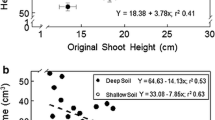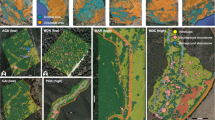Abstract
Total height, diameter, index volume, stem straightness, apical dominance, and survival were assessed at 8 years from seed in an open-pollinated progeny test of 36 families of European chestnut (Castanea sativa Miller) established at two sites in the Atlantic area of Galicia, Spain. Iterative spatial analysis was applied to eliminate the effect of the spatial dependence in the original data and to estimate accurately genetic parameters for evaluating the potential for selection of the measured trees. Spatial analysis was very beneficial for growth traits and survival, but less so if at all for form traits. Estimated individual heritabilities ranged from moderate to high for growth traits (\( \widehat{h}_i^2 = 0.29 - 0.42 \)) and stem straightness (\( \widehat{h}_i^2 = 0.{24} - 0.{42} \)). High coefficients of additive genetic variance were obtained for volume (\( \widehat{\text{C}}{{\text{V}}_{\text{A}}} = {36}.{5} - {41}.{5}\% \)) and straightness (\( \widehat{\text{C}}{{\text{V}}_{\text{A}}} = {44}.{26} - {53}.{84}\% \)). Phenotypic and estimated genetic correlations between growth traits were very high, and correlations between sites indicated that there was no important family × site interaction. No adverse correlations between traits were evident. The results indicate the ample potential for selection in the current progeny trial, where responses to within-family and combined selection for growth traits may be high. Accordingly, three selection scenarios were addressed with the aim to initiate the selection of individuals for implementing the Forest Breeding Plan of Galicia for European chestnut.






Similar content being viewed by others
References
Beineke WF (1983) Genetic improvement of black walnut for timber production. Plant Breed Rev 1:236–266
BOE, n° 27 (13/11/2007) Resolución del 25 de octubre de 2007, de la Dirección General de Agricultura, por la que se publica la ampliación del Catálogo nacional de materiales de base de diversas especies forestales de reproducción de las categorías identificada, cualificada y controlada. España
Burdon RD (1977) Genetic correlation as a concept for studying genotype–environment interaction in forest tree breeding. Silv Genet 26:168–175
Burdon RD (2008) Short note: coefficients of variation in variables with bounded scales. Silv Genet 57(3):178–179
Callister A, Collins S (2008) Genetic parameter estimates in a clonally replicated progeny test of teak (Tectona grandis Linn. f.). Tree Gen Genome 4(2):237–245
Conedera M, Manetti MC, Giudici F, Amorini E (2004) Distribution and economic potential of the Sweet chestnut (Castanea sativa Mill.). Eur Ecol Med 30:179–193
Cornelius J (1994) Heritabilities and additive genetic coefficients of variation in forest trees. Can J For Res 24:372–379
Costa e Silva J, Dutkowski GW, Gilmour AR (2001) Analysis of early tree height in forest genetic trials is enhanced by including a spatially correlated residual. Can J For Res 31:1887–1893
David A, Pike C, Stine R (2003) Comparison of selection methods for optimizing genetic gain and gene diversity in a red pine (Pinus resinosa Ait.) seedling seed orchard. Theor Appl Genet 107:843–849
De la Mata R, Zas R (2010) Transferring Atlantic maritime pine improved material to a region with marked Mediterranean influence in inland NW Spain, a likelihood-based approach on spatially adjusted field data. Eur J For Res 129(4):645–658
Dempfle L (1975) A note on increasing the limit of selection through selection within families. Genet Res 24:127–135
Dempster ER, Lerner IM (1950) Heritability of threshold characters. Genetics 35:212–236
Díaz R, Johnsen O, Fernández-López J (2009) Variation in spring and autumn freezing resistance among and within Spanish wild populations of Castanea sativa. Ann For Sci 66:708–720
Díaz R, Zas R, Fernández-López J (2007) Genetic variation of Prunus avium in susceptibility to cherry leaf spot (Blumeriella jaapii) in spatially heterogeneous infected seed orchards. Ann For Sci 64:21–30
Dutkowski GW, Costa e Silva J, Gilmour AR, Lopez GA (2002) Spatial analysis methods for forest genetic trials. Can J For Res 32:2201–2214
Dutkowski GW, Costa e Silva J, Gilmour AR, Wallendorf H, Aguiar A (2006) Spatial analysis enhances modelling of a wide variety of traits in forest genetic trials. Can J For Res 36:1851–1870
Elorrieta J (1949) El castaño en España. MAPA, Madrid
Eriksson G, Ekberg I (2001) An introduction to forest genetics. Swedish University of Agricultural Sciences, Upsala
Falconer DS (1989) Introduction to quantitative genetics. Oliver and Boyd, Edinburgh
Falconer DS, Mackay TFC (2001) Introducción a la genética cuantitativa, 4th edn. Editorial Acribia S.A, Zaragoza
Fernández-López J (2011) Identification of the genealogy of interspecific hybrids between Castanea sativa, Castanea crenata and Castanea mollissima. For Syst 20(1):65–80
Fernandez-Lopez J, Alia R (2003) EUFORGEN technical guidelines for genetic conservation and use for chestnut (Castanea sativa). International Plant Genetics Research Institute, Rome
Fernández-López J, Aravanopoulos FA, Botta R, Villani F, Alizoti PA, Cherubini M, Mellano G, Zas R, Díaz R, Eriksson G (2005) Geographic variability among extreme European wild chestnut. Acta Hortic (ISHS) 693:181–186
Fernández-López J, Díaz-Vázquez R, Cogolludo Agustín MA, Pereira Lorenzo S (2000) Conservación de frondosas nobles en España. Inv Agric Sist Rec For 2:71–94
Fernández-López J, Miranda-Fontaíña ME, Furones-Pérez P (2008) Caracteres de selección en campo de clones de castaño híbrido (Castanea crenata × Castanea sativa) para la producción de madera. Cuad Soc Esp Cienc For 24:39–43
Fernández-López J, Pereira-Lorenzo S, Miranda-Fontaiña ME (1992) Fog and substrate conditions for chestnut propagation by leafy cuttings. Symposium proceedings Mass Production Technology for Genetically improved fast growing species, Tome I. AFOCEL/IUFRO, pp 379–383
Fu Y, Yanchuk AD, Namkoong G, Fu YB (1999) Spatial patterns of tree height variations in a series of Douglas-fir progeny trials: implications for genetic testing. Can J For Res 29:714–723
García del Barrio JM, De-Miguel J, Alía R, Iglesias S (2001) Regiones de Identificación y Utilización de material forestal de reproducción. Ministerio de Medio Ambiente. Serie cartográfica. Ministerio de Medio Ambiente, Madrid
Hamann A, Namkoong G, Koshy MP (2002) Improving precision of breeding values by removing spatially autocorrelated variation in forestry field experiments. Silv Genet 51:5–6
Kowalczyk J (2005) Comparison of phenotypic and genetic selection in Scots pine (Pinus sylvestris L.) single tree plot half-sib progeny tests. Dendrobiology 53:45–46
Manetti MC, Amorini E, Becagli C, Conedera M, Giudici F (2001) Productive potential of chestnut (Castanea sativa Mill.) stands in Europe. For Snow Landscape Res 76(3):471–476
Manino A, Patetta A, Marletto F (1991). Investigations on chestnut pollination. 6th Pollination Symp., Acta Hort (ISHS), pp 335–339
Miranda-Fontaiña ME, Fernández-López J (1992) The micropropagation of chestnut tree: in vivo establishment and post-propagation growth. In: Symposium Proceedings Mass Production Technology for Genetically Improved Fast Growing Forest Tree Species I, pp 421–426
Miranda-Fontaiña ME, Fernández-López J (1995) Aclimatación, cultivo en vivero y calidad de planta de castaño micropropagado. ITEA 9(3):149–156
Miranda-Fontaiña ME, Fernández-López J (2001) Genotypic and environmental variation of Castanea crenata × C. sativa and Castanea sativa clones in aptitude to Micropropagation. Silv Genet 50(3–4):153–162
Miranda-Fontaiña ME, Fernández-López J (2005) Effect of genotype on micropropagation and post-propagation growth of 35 commercial clones of Castanea sp. Acta Hort (ISHS) 693:313–320
Miranda-Fontaiña ME, Fernández-López J, Vettraino AM, Vannini A (2007) Resistance of Castanea clones to Phytophthora cinnamomi: testing and genetic control. Silv Genet 56(1):11–21
Oiveira D, Gomes A, Ilaarco F, Manteigas A, Pinto J, Ramalho J (2001). Importance of insect pollinators for the production in the chestnut, Castanea sativa. 8th Pollination Symp. Acta Hort (ISHS), pp 269–273
Pliura A, Eriksson G (2002) Genetic variation in juvenile height and biomass of open-pollinated families of six Castanea sativa MILL. Populations in a 2 × 2 factorial temperatures × watering experiment. Silv Genet 51:152–160
Rubio A, Elena R, Sánchez O, Blanco A, Gómez V, Graña D (2001) Hábitat edáfico de los castañares de Galicia (España). Edafología 8(2):1–12
SAS Institute Inc (2002–2003) SAS 9.1. SAS Institute, Cary
SAS Institute (1999) SAS/STAT user’s guide, Version 8 [computer program]. SAS Institute, Cary
Tchatchoua DT, Aravanopoulos FA (2010) Evaluation of selected European chestnut (Castanea sativa) provenances II: intra-provenance family variation. Acta Hort (ISHS) 866:215–224
Terrance ZYe, Jayawickrama KJS (2008) Efficiency of using spatial analysis in first-generation coastal Douglas-fir progeny tests in the US Pacific Northwest. Tree Gen Genome 4:677–692
Toval G (2010) Plan de Innovación y Mejora Forestal de Galicia (2010–2020). Centro de Investigación Forestal de Lourizán, Dirección Xeral de Montes, Consellería de Medio Rural, Xunta de Galicia, Galicia
Vannini A, Natili G, Anselmo N, Montaghi A, Vetraino AM (2010) Distribution and gradient analysis of Ink disease in chestnut forests. For Path 40:73–86
Wright JW (1976) Introduction to forest genetics. Academic, New York
Xie CY (2008) Ten-year results from red alder (Alnus rubra Bong.) provenance-progeny testing and their implications for genetic improvement. New For 36:273–284
Xie CY, Carlson MR, Murphy JC (2007) Predicting individual breeding values and making forward selections from open-pollinated progeny test trials for seed orchard establishment of interior lodgepole pine (Pinus contorta ssp. latifolia) in British Columbia. New For 33:125–138
Xie CY, Ying CC (1996) Heritabilities, age-age correlations, and early selection in lodgepole pine (Pinus contorta spp. latifolia). Silv Genet 45:101–110
Zas R, Sampedro L, Moreira X, Martíns P (2008) Effect of fertilization and genetic variation on susceptibility of Pinus radiata seedlings to Hylobius abetis damage. Can J For Res 38:63–72
Zas R (2006) Iterative kriging for removing spatial autocorrelation in analysis of forest genetic trials. Tree Gen Genom 2(4):177–186
Zas R (2008a) Autocorrelación espacial y el diseño y análisis de experimentos. In: Maestre F, Escudero A, Bonet A (eds) Introducción al análisis espacial de datos en ecología y ciencias ambientales, métodos y aplicaciones. Universidad Rey Juan Carlos, Asociación Española de Ecología Terrestre y Caja de Ahorros del Mediterráneo, Madrid, pp 542–590
Zas R (2008b) The impact of spatial heterogeneity on selection, a case study on Pinus pinaster breeding seedling orchards. Can J For Res 38:114–124
Zobel B, Talbert J (1984) Applied forest tree improvement. Wiley, New York
Acknowledgments
This study was initially supported by the R + D project SC99-036-C2 funded by the Sectorial Program of Agrarian and Food of MAPA and currently by the INIA project RTA2009-00163-00-00. The authors thank María Emérita Blanco for the selection of plus trees and the sowed seed and cultured seedlings in the greenhouse, Miguel Jamardo and Agustín Quintairós by the establishment and initial care of the progeny plantation, José María Mendaña and Maribel Juncal for their help in the field assessments, and Pilar Furones and Raquel Díaz for their advices in statistics. We thank to the landowners Don Manuel Varela and the Neighboring Community of Mountains of Rebordelo who gave permission to plant the trees and collaborated with us on several occasions. Finally, we would like to thank Dr. Rowland Burdon for the helpful comments and suggestions for editing the manuscript.
Author information
Authors and Affiliations
Corresponding author
Additional information
Communicated by R. Burdon
Rights and permissions
About this article
Cite this article
Míguez-Soto, B., Fernández-López, J. Genetic parameters and predicted selection responses for timber production traits in a Castanea sativa progeny trial: developing a breeding program. Tree Genetics & Genomes 8, 409–423 (2012). https://doi.org/10.1007/s11295-011-0451-x
Received:
Revised:
Accepted:
Published:
Issue Date:
DOI: https://doi.org/10.1007/s11295-011-0451-x




